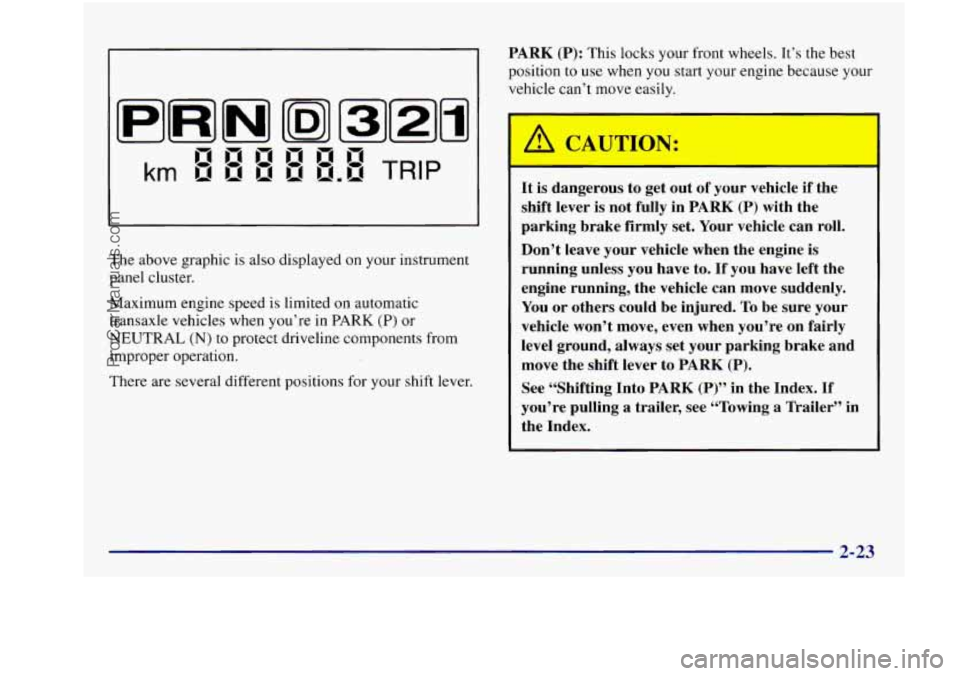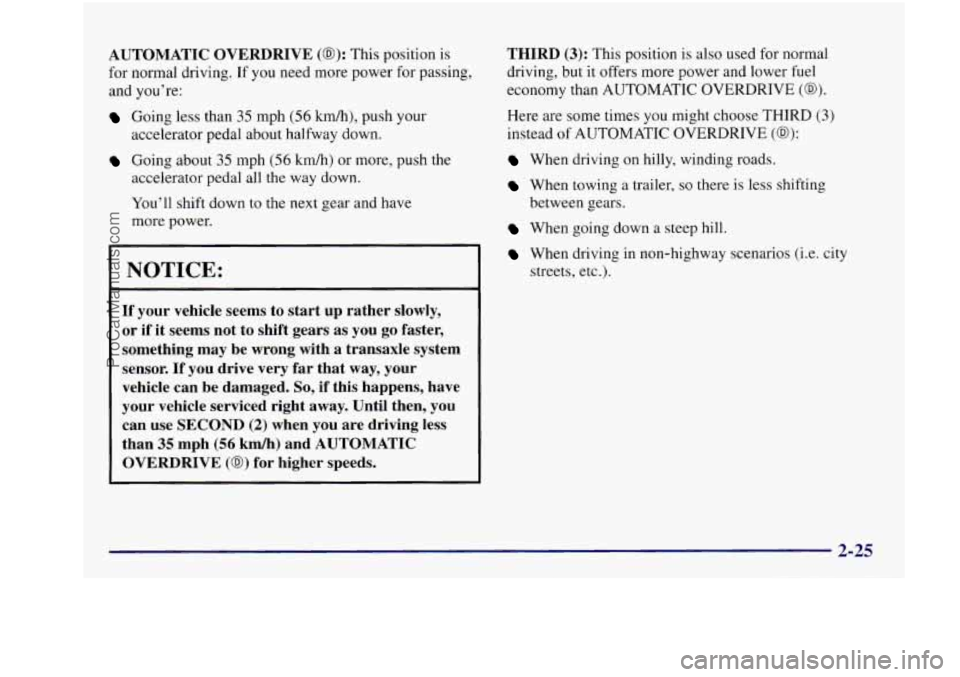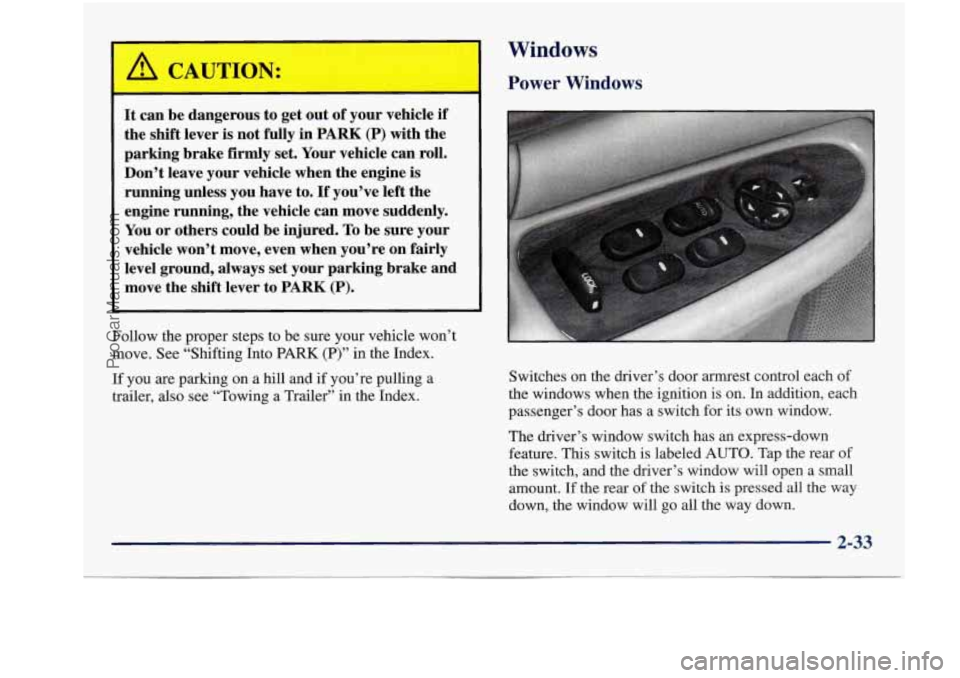Page 94 of 422
New Vehicle “Break-In” Ignition
Positions
NOTICE:
Your modern Buick doesn’t need an elaborate
“break-in.” But
it will perform better in the long
run
if you follow these guidelines:
0
0
0
Don’t drive at any one speed -- fast or
slow
-- for the first 500 miles (805 km).
Don’t make full-throttle starts.
Avoid making hard stops for the first
200 miles (322 km) or so. During this time
your new brake linings aren’t yet broken
in. Hard stops with new linings can mean
premature wear and earlier replacement.
Follow this breaking-in guideline every
time
you get new brake linings.
Don’t tow a trailer during break-in. See
“Towing a Trailer”
in the Index for more
information.
A 1.
With the ignition key in the ignition switch, you can turn
the switch to five positions:
ACC (A): This position lets you use the radio and
windshield wipers when the engine is
off. To use ACC
(Accessory), push in the key and turn it toward you.
Your steering wheel will stay locked.
2-18
ProCarManuals.com
Page 99 of 422

I I PARK (P): This locks your front wheels. It’s the best
I position to use when you start your engine because your
I I vehicle can’t move easilv.
-:
d
B I B I B!I BJ LI ------
km Irr Irr ,,r u ,,r,,,r TRIP
It is dangerous to get out of your vehicle if the
‘I
shift lever is not fully in PARK (P) with the
parking brake firmly set. Your vehicle can roll.
The above graphic is also displayed on your instrument
panel cluster.
Maximum engine speed
is limited on automatic
transaxle vehicles when you’re in PARK (P) or
NEUTRAL
(N) to protect driveline components from
improper operation.
There are several different positions for your shift lever.
Don’t leave your vehicle when the engine is
running unless you have to.
If you have left the
engine running, the vehicle can move suddenly.
You or others could be injured.
To be sure your
vehicle won’t move, even when you’re on fairly
level ground, always set your parking brake and
move the shift
lever to PARK (P).
See “Shifting Into PARK (P)” in the Index. If
you’re pulling a trailer, see “Towing a Trailer’’ in
the Index.
2-23
ProCarManuals.com
Page 101 of 422

AUTOMATIC OVERDRIVE (0): This position is
for normal driving. If you need more power for passing,
and you’re:
Going less than 35 mph (56 kmh), push your
Going about 35 mph (56 kmk) or more, push the
accelerator pedal about
halfway down.
accelerator pedal all the way down.
You’ll shift down to the
next gear and have
more power.
NOTICE:
I If your vehicle seems to start up rather slowly,
or
if it seems not to shift gears as you go faster,
something may be wrong with a transaxle system
sensor.
If you drive very far that way, your
vehicle can be damaged.
So, if this happens, have
your vehicle serviced right away. Until then, you
can use SECOND
(2) when you are driving less
than
35 mph (56 km/h) and AUTOMATIC
OVERDRIVE (0) for higher speeds.
THIRD (3): This position is also used for normal
driving, but it offers more power and lower fuel
economy than AUTOMATIC OVERDRIVE
(@).
Here are some times you might choose THIRD (3)
instead of AUTOMATIC OVERDRIVE (0):
When driving on hilly, winding roads.
When towing a trailer, so there is less shifting
When going down a steep hill.
When driving in non-highway scenarios (i.e. city
between
gears.
streets, etc.).
2-25
~
ProCarManuals.com
Page 104 of 422
Parking Brake
To set the parking brake,
hold the regular brake
pedal down with your
right foot. Push down
the
parking brake pedal with
your
left foot,
To release the parking brake, hold the regular brake
pedal down with your right foot and push the parking
brake pedal with your left foot. When
you lift your left
foot, the parking brake pedal will follow it
to the
released position.
A warning chime will sound if the parking brake is set,
the ignition
is on and the shift lever is not in PARK (P)
or NEUTRAL (N).
I NOTICE:
Driving with the parking brake on can cause
your rear brakes to overheat. You may have to
replace them, and
you could also damage other
parts
of your vehicle.
If you are towing a trailer and are parking on any hill,
see “Towing
a Trailer” in the Index. That section shows
what
to do first to keep the trailer from moving.
2-28
ProCarManuals.com
Page 105 of 422
Shifting Into PARK (P) 2. Move the shift lever into the PARK (P) position
like this:
It can be dangerous to get out of your vehicle if
the shift lever
is not fully in PARK (P) with the
parking brake firmly set. Your vehicle can roll.
If you have left the engine running, the vehicle
can move suddenly. You or others could be
injured.
To be sure your vehicle won’t move, even
when you’re on fairly level ground, use the steps
that follow.
If you’re pulling a trailer, see
“Towing
a Trailer” in the Index.
1. Hold the brake pedal down with your right foot and
set the parking brake with your left foot. Hold in the button on the
lever, and
push the lever
all the way toward the
front
of your vehicle.
3. Move the ignition key to LOCK.
4. Remove the key and take it with you. If you can
leave your vehicle
with the ignition key in your
hand, your vehicle is in
PARK (P).
2-29
ProCarManuals.com
Page 109 of 422

I
I
It can be dangerous to get out of your vehicle if
the shift lever is not fully in PARK (P) with the
parking brake
firmly set. Your vehicle can roll.
Don’t leave your vehicle when the engine
is
running unless you have to. If you’ve left the
engine running, the vehicle can move suddenly.
You or others could be injured.
To be sure your
vehicle won’t move, even when you’re on fairly
level ground, always set your parking brake and
move the shift lever to
PARK (P).
Follow the proper steps to be sure your vehicle won’t
move. See “Shifting Into
PARK (P)” in the Index.
If you are parking on a hill and if you’re pulling a
trailer, also see “Towing a Trailer” in the Index.
Windows
Power Windows
Switches on the driver’s door armrest control each of
the windows when the ignition is on. In addition, each
passenger’s door has a switch for its own window.
The driver’s window switch has an express-down
feature. This switch is labeled
AUTO. Tap the rear of
the switch, and the driver’s window will open a small
amount. If the rear of the switch
is pressed all the way
down, the window will go all the way down.
2-33
ProCarManuals.com
Page 146 of 422

NOTICE:
If you keep driving your vehicle with this light
on, after a while, your emission controls may not
work as well, your fuel economy may not be as
good and your engine may not run as smoothly.
This could lead
to costly repairs that may not be
covered by your warranty.
This light should come on, as a check to show you it is
working, when the ignition is on and the engine is not
running.
If the light doesn’t come on, have it repaired.
This light will also come on during a malfunction in one
of two ways:
0
0
Light Flashing -- A misfire condition has been
detected.
A misfire increases vehicle emissions and
may damage the emission control system on your
vehicle. Dealer or qualified service center diagnosis
and service is required.
Light On Steady -- An emission control system
malfunction has been detected on your vehicle.
Dealer or qualified service center diagnosis and
service may be required.
If the Light Is Flashing
The following may prevent more serious damage to
your vehicle:
Reducing vehicle speed.
0 Avoiding hard accelerations.
0 Avoiding steep uphill grades.
0 If you are towing a trailer, reduce the amount of
cargo being hauled as soon as it is possible.
If the light stops flashing and remains on steady, see “If
the Light Is On Steady” following.
If the light continues to flash, when
it is safe to do so,
stop the vehicle. Find a safe place to park your vehicle.
Turn the key off, wait at least 10 seconds and restart the
engine. If the light remains on steady, see “If the Light
Is On Steady” following. If the light is still flashing,
follow the previous steps, and drive the vehicle to your
dealer or qualified service center for service.
2-70
ProCarManuals.com
Page 197 of 422
Section 4 Your Driving and the Road
Here you’ll find information about driving on different kinds of roads and in varying weather conditions. We’ve also
included many other useful tips on driving.
4-2 4-3
4-6
4-6
4-12
4-14
4-15
4-16
4- 17 Defensive Driving
Drunken Driving
Control of a Vehicle
Braking
Steering
Off-Road Recovery
Passing
Loss
of Control
Driving at Night 4-19
4-22
4-23
4-24
4-25
4-25
4-27
4-3 1
4-33 Driving
in Rain and on Wet Roads
City Driving
Freeway Driving Before Leaving on a Long Trip
Highway Hypnosis
Hill and Mountain Roads
Winter Driving
Loading Your Vehicle
Towing a Trailer
ProCarManuals.com